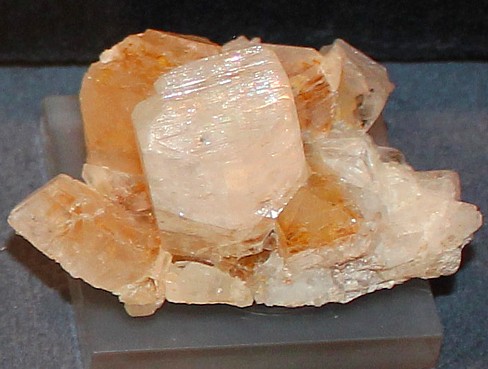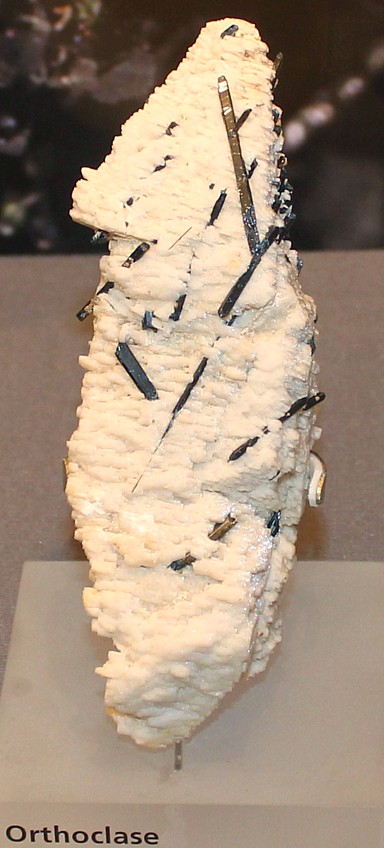|
.
Orthoclase Mineral Facts:
Chemical Formula: KAlSi3O8
A Potash Feldspar or K-spar.
Potassium-aluminium silicate, with Silica 64.7%, alumina 18.4%,
potassium 16.9%. Sodium sometimes replaces a portion of the potash.
Colors:
white, gray, flesh-red, more rarely green.
The streak
of
orthoclase is white.
Hardness:
6 to 6.5
Density: 2.5
to 2.6
Cleavage:
Two prominent
cleavages (one parallel to base, perfect: the other parallel to
clinopinacoid, good), making an angle of 90 degrees with each other.
Crystallography: Monoclinic
Crystals are usually prismatic in habit and
have as prominent forms; clinopinacoid, base, prism, with often smaller
orthodomes. Frequently twinned; Carlsbad with clinopinacoid as twinning
plane; Baveno with clinodome as twinning plane; Manebach with base as
twinning plane.
Usually crystallized or coarsely cleavable to granular; more rarely
fine-grained, massive and cryptocrystalline..
Luster:.
Vitreous
luster. It is opaque to transparent.
|

Orthoclase crystals, close up |
|
Composition,
Structure and Associated Minerals:
Orthoclase occurs in rectangular sections, and also in
shapeless masses in rock slices. Specimens are usually white or colorless;
often cloudy by alteration. Common orthoclase feldspar is the usual opaque
variety. Adularia is white or colorless and translucent to transparent. Some
adularia shows an opalescent play of colors, and is called moonstone. Most
of the moonstones, however, belong to the members of the plagioclase
feldspar series. Sanidine, or glassy feldspar, is a variety occurring in
glassy, often transparent, phenocrysts in eruptive rocks. The name
orthoclase refers to the right-angle cleavage possessed by the mineral.
Feldspar is derived from the German word feld, meaning field. Orthoclase and
microcline have the same chemical composition. Both are potash feldspars,
but both may contain sodium. The most noticeable difference between
orthoclase and microcline is that the latter shows clearly its triclinic
symmetry by its twinning, and its optical properties, while in orthoclase
the twinning is so minute as to be unobservable and the optical properties
are similar to those of monoclinic crystals. This difference is best
exhibited in thin sections when viewed in polarized light under the
microscope. Under these conditions certain sections of microcline exhibit
series of light and dark bars crossing one another perpendicularly, while
sections of orthoclase do not. The grating structure is due to repeated
twinning according to the albite and pericline laws at the same time. If
this method of twinning is present in orthoclase the lamellae are so minute
that they cannot be seen even under high powers of the microscope.
Of the feldspars, orthoclase and microcline are types more frequently found
as large crystals, and both occur extensively as constituents of granite.
Several names that refer to more or less distinct varieties of the potash
feldspars are in common use. The most important are:
Adularia, a nearly pure orthoclase, that is nearly transparent, occurring
in veins. Its crystals have the characteristic habit illustrated in Sanidine,
a glassy soda orthoclase, occurring as large crystals often flattened
parallel to 010, embedded in lavas. Moonstone, a translucent adularia,
exhibiting a pearly luster, with a very slight play of colors. Sunstone, a
translucent variety exhibiting reddish flashes from inclusions of mica, or
other platy minerals. Perthite, parallel intergrowths of thin lamellae of
orthoclase and
albite. Microcline-perthite, parallel intergrowths of lamellae of microcline
and albite. When acted upon by waters carrying carbon dioxide in
solution, orthoclase alters, forming a soluble carbonate of potassium and
leaving as a residue either a mixture of kaolin and quartz (Si02),
or of muscovite and quartz. Kaolin forms the chief constituent of clays and
has been derived in this manner.
|

Orthoclase Feldspar (white) |
|
|
Identification and Diagnostics
Before the blowpipe it is difficultly fusible (at 5). Insoluble in
acids. When mixed with powdered gypsum and heated on platinum wire gives the
violet flame of potassium. Usually to be recognized by its color, hardness
and cleavage. Distinguished from the other feldspars by its right-angle
cleavage and the lack of striations on the best cleavage surface. Orthoclase
may be distinguished from the other pseudomonoclinic feldspars by its
specific gravity and the flame reaction.
Occurrence,
Localities and Origins:
Orthoclase is one of the most common of
minerals. Widely distributed as a prominent rock constituent, occurring in
all types of rocks; igneous, in granites, syenites, porphyries, etc.;
sedimentary, in certain sandstones and conglomerates; metamorphic, in
gneisses. Also in large crystals and cleavable masses in pegmatite veins,
associated chiefly with quartz, muscovite and albite. These veins are to be
found where granite rocks abound. Large veins of this character from which
feldspar is quarried in considerable amounts occur in the New England and
Middle Atlantic states, chiefly in Maine, Connecticut, New York,
Pennsylvania and Maryland. Moonstone is an opalescent feldspar, and is
usually orthoclase. The chief source is Ceylon, where it occurs as large
crystals and lenticular masses of opalescent orthoclase in a kaolinized
granulite (a fine-grained rock consisting of quartz and feldspar) at various
localities, notably in the Kandy district, Central Province, and at
Ambalangoda, Southern Province. Moonstone of inferior quality is found in
the Ceylon pegmatites. The mineral also occurs at Amelia, Virginia, in the
USA.
The potash feldspars are
essential constituents of the igneous rocks granite, syenites, rhyolites and
trachytes and of some crystalline schists, and are accessory components of a
number of other rocks. They occur in most pegmatite dikes and as gangue
minerals in some ore veins, and in many contact metamorphosed rocks. The
potash feldspars are so widely spread that an enumeration of their important
occurrences is here impossible. The best known localities of orthoclase are
Cunnersdorf, Silesia; Drachenfels and Lake Laach, Rhenish Prussia (sanidine)
; in the Zillerthal, Tyrol (adularia); at St. Gothard in the Alps
(adularia); at Baveno, Italy, and at Mt. Antero, Chaffee Co., Colorado. Anorthoclase occurs at Tyveholmen and other points in Norway and in the lava
of Kilimandjaro, Africa, and in that on Pantelleria, an island near Sicily.
In North America pegmatites are abundant in southeastern Canada, in
New England and in the Piedmont plateau area immediately east of the
Appalachian Mts., and throughout this district all forms of the opaque
potash feldspars are abundant. Soda-potash feldspars have been described
from many places, but whether they are soda orthoclase or anortholcase has
rarely been determined. All phases of the alkali feldspars occur as
components of igneous and metamorphic rocks..
Return to the
Mineral Collectors Information Page |
|


